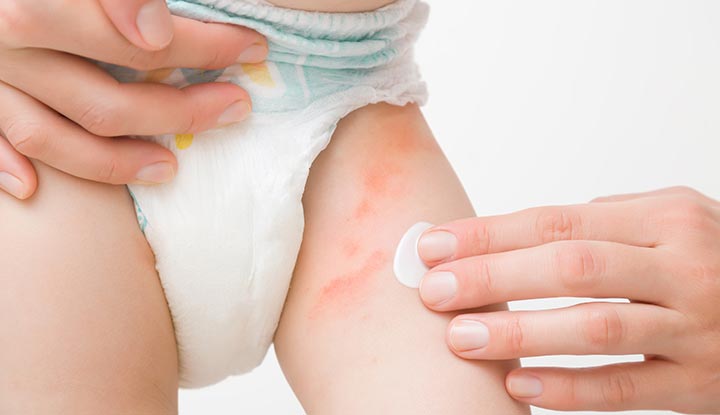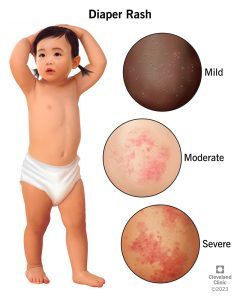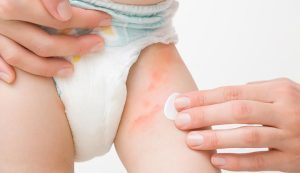Yeast diaper rash pictures help to identify and treat diaper rash quickly. These visual cues show red, inflamed skin with distinct raised edges and small red spots.
Yeast diaper rash is a common issue in babies caused by an overgrowth of yeast in moist diaper areas. It appears as a bright red rash, often with raised borders and small red dots scattered within the rash. By recognizing the specific characteristics of yeast diaper rash through pictures, parents and caregivers can provide prompt treatment to alleviate discomfort and promote healing for their little ones.
Identifying and addressing yeast diaper rash promptly can prevent it from worsening and ensure the baby’s skin stays healthy and free from irritation.
:max_bytes(150000):strip_icc()/what-are-the-symptoms-of-a-yeast-diaper-rash-284384_hl1-c1437d0be6194ce692af523feaf7fb2f.png)
What Is Yeast Diaper Rash?
Yeast diaper rash is a common issue among infants, caused by the Candida fungus. These rashes can be stubborn to treat and require specific care to clear up effectively. Understanding the causes, symptoms, and treatment of yeast diaper rash is crucial for parents and caregivers to provide the best care for their little ones.
Causes Of Diaper Rash
Yeast diaper rash is typically caused by the overgrowth of Candida, a type of fungus that thrives in warm, moist environments.
Symptoms Of Yeast Diaper Rash
The symptoms of yeast diaper rash include bright red skin, intense redness in the folds, and satellite pustules.

Identifying Yeast Diaper Rash
Yeast diaper rash is a common infection that can occur in babies and toddlers. It is important for parents to be able to identify this type of rash to ensure proper treatment and relief for their little ones. By understanding the visual characteristics and distinguishing features of yeast diaper rash from other rashes, you can effectively address the issue and provide your child with the care they need. Let’s take a closer look at how to identify yeast diaper rash.
Visual Characteristics
Yeast diaper rash typically presents with distinct visual characteristics that can help differentiate it from other types of rashes. When examining your baby’s diaper area, here are some signs to look out for:
- Red, raised, and often shiny spots on the skin
- Pimple-like bumps or open sores
- Bright red patches that may expand
- Well-defined borders
- Presence of small, scattered satellite lesions
These visual indicators are often a telltale sign of yeast infection and can assist parents in promptly identifying the problem.
Distinguishing From Other Rashes
While some rashes may share a few similarities with yeast diaper rash, there are certain distinguishing features that can help differentiate it from other common types of rashes. It’s essential to be aware of these distinctions to ensure accurate diagnosis and suitable treatment. Here are some key factors to consider when differentiating yeast diaper rash from other rashes:
| Yeast Diaper Rash | Other Common Rashes |
|---|---|
| Bright red patches with defined borders | Blotchy or uneven redness |
| Presence of pimple-like bumps | No pimple-like bumps |
| Shiny appearance | No shiny appearance |
| Small satellite lesions | No satellite lesions |
By comparing these distinct characteristics, you can more accurately identify whether your child is experiencing yeast diaper rash or another type of rash, leading to more targeted and effective treatment.
Treatment Options
When it comes to treating yeast diaper rash, parents have several options. Medical interventions, home remedies, and prevention strategies can all play a role in soothing your baby’s discomfort and promoting healing.
Medical Interventions
If your baby’s yeast diaper rash is severe or not responding to home remedies, it may be necessary to seek medical intervention. A pediatrician or healthcare provider can assess the rash and recommend appropriate treatments, which may include:
- Antifungal Medications: Prescription antifungal creams or ointments, such as nystatin or clotrimazole, may be prescribed to address the yeast infection. These medications are typically applied to the affected area a few times a day until the rash resolves.
- Oral Antifungal Medications: In some cases, oral antifungal medications may be necessary to combat stubborn yeast infections. These medications, like fluconazole, are typically prescribed for a short course and should be taken as directed by the healthcare provider.
Home Remedies And Prevention
In addition to medical interventions, there are several home remedies and prevention strategies that can help treat and prevent yeast diaper rash. These options include:
- Keep the Area Clean and Dry: Regularly change your baby’s diaper and gently cleanse the affected area with warm water. Pat dry thoroughly before applying any creams or ointments.
- Use Barrier Creams: Apply a protective barrier cream, such as zinc oxide or petroleum jelly, to create a barrier between your baby’s skin and the dampness of the diaper. This can help prevent further irritation and promote healing.
- Avoid Irritants: Avoid using scented wipes, soaps, or lotions, as these can further irritate your baby’s sensitive skin. Opt for gentle, fragrance-free products instead.
- Use Cloth Diapers: If possible, consider using cloth diapers instead of disposable ones. Cloth diapers allow for better airflow and can help keep your baby’s skin dryer. Be sure to wash cloth diapers with a gentle detergent and rinse them thoroughly to remove any irritants.
- Allow Diaper-Free Time: Allow your baby to have some diaper-free time each day to let their skin breathe. Place a waterproof mat or towel underneath to catch any accidents.
By combining medical interventions, home remedies, and prevention strategies, you can effectively treat your baby’s yeast diaper rash and provide relief from discomfort. Remember to consult with a healthcare professional for personalized advice and guidance.
Precautions And Considerations
When dealing with yeast diaper rash pictures, it is essential to take proper precautions and considerations to ensure your baby’s health and well-being.
When To Consult A Doctor
If the rash persists after home remedies, seek medical advice promptly.
Risk Factors To Watch Out For
Look out for prolonged or severe rash, fever, or discharge from the rash site.
Yeast Diaper Rash In Different Age Groups
Yeast diaper rash is a common issue that can affect children of all ages. Understanding how yeast diaper rash presents in different age groups can help parents and caregivers effectively manage and treat the condition.
Infants
In infants, yeast diaper rash often appears as bright red patches with distinct borders in the diaper area.
- Prone to yeast diaper rash due to frequent diaper changes
- May experience discomfort or fussiness
- Treatment may include antifungal creams
Toddlers And Older Children
Toddlers and older children can also develop yeast diaper rash, characterized by persistent redness and soreness.
- May refuse diaper changes due to pain
- Keeping the diaper area clean and dry is crucial
- Consult a healthcare provider for proper diagnosis and treatment
Real-life Yeast Diaper Rash Encounters
Explore real-life yeast diaper rash encounters with detailed yeast diaper rash pictures. Understand the signs and symptoms to identify and effectively treat yeast diaper rash in babies. Get insights into prevention and the best practices for soothing and healing your little one’s delicate skin.
- Parents’ Experiences
- Pediatrician Insights
- The Visual Journey Of Yeast Diaper Rash
Yeast diaper rash can be visually distressing for parents, as it presents differently from other common types of rashes. Understanding the visual cues of yeast diaper rash through pictures is essential to provide adequate care for your little one.
Infant Case Study
Observe a real-life example to comprehend the impact of yeast diaper rash on infants. Documented cases offer insight into the severity and progression of this specific type of rash.
Comparison With Other Types Of Rashes
Contrast yeast diaper rash with other types to help parents differentiate and identify the specific characteristics. Recognizing these distinctions aids in prompt treatment and relief for the baby’s discomfort.
:max_bytes(150000):strip_icc()/GettyImages-1155895723-c58db22547a9491eac5cdf73fbc949f3.jpg)
Maintaining Healthy Diaper Care Practices
Maintaining healthy diaper care practices is crucial for preventing and treating yeast diaper rash. This condition can be identified through yeast diaper rash pictures, showing redness, scaling, and pustules. Regular diaper changes, gentle cleaning, and using a barrier cream can help alleviate and prevent yeast diaper rash.
Maintaining proper diaper care practices is crucial to preventing yeast diaper rash in infants. Yeast diaper rash, also known as candida diaper dermatitis, can cause discomfort and irritation to your little one. By following these simple hygiene tips and selecting the right diaper products, you can create a clean and healthy diaper environment for your baby.
Hygiene Tips
Good hygiene plays a vital role in preventing yeast diaper rash. Here are some practical tips to help you maintain a clean diaper area for your baby:
- Change your baby’s diaper frequently, ideally every 2 to 3 hours, or as soon as it becomes soiled.
- Gently clean the diaper area during each diaper change. Use a mild, fragrance-free cleanser or warm water and a soft cloth to wipe away any urine or feces.
- Make sure to thoroughly dry the diaper area after cleaning. Patting the skin gently with a towel can help prevent excess moisture.
- Avoid using baby wipes with alcohol or fragrance, as these can further irritate the delicate skin.
- Allow some diaper-free time to air out your baby’s bottom. This can help reduce moisture and promote healing.
Choosing The Right Diaper Products
Finding the right diaper products is a crucial step in maintaining healthy diaper care practices. Consider the following factors while selecting diapers for your little one:
- opt for diapers with high absorbency to keep your baby’s skin dry. Look for indicators of wetness, such as a color-changing line.
- Choose diapers that have a soft and breathable material, such as cotton or hypoallergenic options, to allow proper air circulation.
- Ensure the diaper has a snug, but not too tight, fit. This helps to prevent leaks and reduces friction against your baby’s delicate skin.
- Consider using diaper creams or ointments that create a protective barrier between your baby’s skin and moisture. Look for products specifically formulated for diaper rash prevention.
Remember, maintaining healthy diaper care practices is essential for your baby’s comfort and well-being. By practicing good hygiene and choosing the right diaper products, you can help prevent yeast diaper rash and keep your baby’s skin healthy and happy.
What Does A Yeast Diaper Rash Look Like?
A yeast diaper rash appears as bright red, with distinct borders and may have raised bumps. It can spread to the folds and creases of the skin. Prompt treatment is essential.
How To Tell Difference Between Diaper Rash And Yeast Infection?
Diaper rash is red and bumpy, while a yeast infection has raised, red bumps with distinct borders.
What Does Infected Diaper Rash Look Like?
Infected diaper rash appears red, swollen, and may have blisters or pus-filled sores. It is often accompanied by fever and can be painful for babies. Immediate medical attention is recommended to prevent further complications.
What Does A Yeast Rash Look Like?
A yeast rash appears as red, inflamed patches with distinct borders and may have satellite lesions.
Conclusion
In your quest for dealing with yeast diaper rashes, remember that prevention is key. By identifying the symptoms early and seeking advice from a healthcare professional, you can provide relief for your little one. Stay informed, stay proactive, and keep your baby’s skin healthy. Let’s beat that rash!





